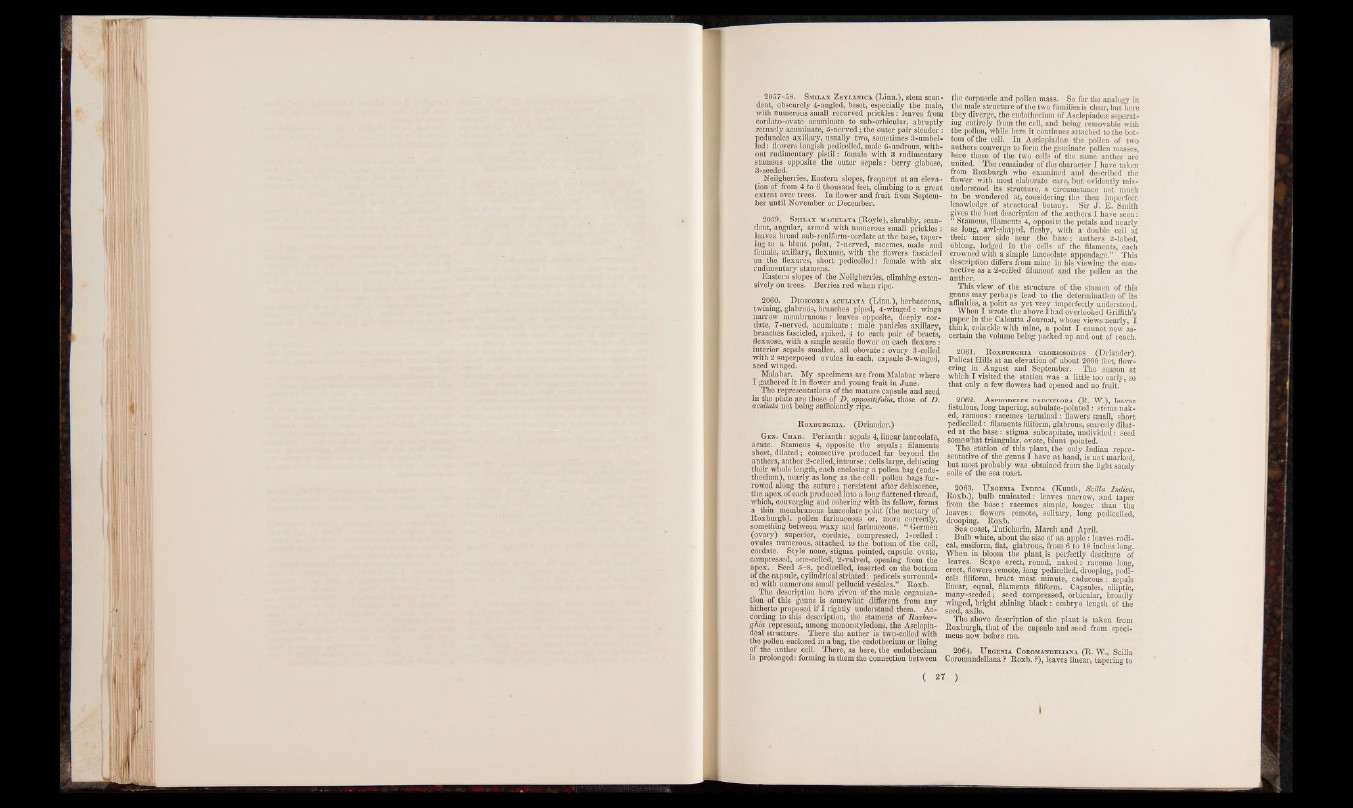
2057-58. Smilax Zeylanica (Linn.), stem scan-
dent, obscurely 4-angled, beset, especially the male,
with numerous small recurved prickles: leaves from
cordato-ovate acuminate to sub-orbicular, abruptly
retusely acuminate, 5-nerved; the outer pair slender:
peduncles axillary, usually two, sometimes 3-umbel-
led: flowers longish pedicelled, male 6-androus, without
rudimentary pistil: female with 3 rudimentary
stamens opposite the outer sepals: berry globose,
3-seeded.
Neilgherries, Eastern slopes, frequent at an elevation
of from 4 to 6 thousand feet, climbing to a great
extent over trees. In flower and fruit from September
until November or December.
2059. Smilax maculata (Royle), shrubby, sdan-
dent, angular, armed with numerous small prickles:
leaves broad sub-reniform-cordate at the base, tapering
to a blunt point, 7-nerved, racemes, male and
female, axillary, flexuose, with the flowers fascicled
on the flexures, short pedicelled: female with six
rudimentary stamens.
Eastern slopes of the Neilgherries, climbing extensively
on trees. Berries red when ripe.
2060. D ioscorea aculiata (Linn.), herbaceous,
twining, glabrous, branches piped, 4-winged: wings
narrow membranous.: leaves opposite, deeply cordate,
7-nerved, acuminate: male panicles axillary,
branches fascicled, spiked, 4 to each pair of bracts,
flexuose, with a single sessile flower on each flexure :
interior sepals smaller, all obovate: ovary 3-celled
with 2 superposed ovules in edch, capsule 3-winged,
seed winged.
Malabar. My specimens are from Malabar where
I gathered it in flower and young fruit in June.
The representations of the mature capsule and seed
in the plate are those of D. oppositifolia, those of D.
aculiata not being sufficiently ripe.
R oxburghia. (Driander.)
Gen. Char. Perianth: sepals 4, linear lanceolate,
acute. Stamens 4, opposite the sepals; filaments
short, dilated; connective produced far beyond the
anthers, anther 2-celled, introrse; cells large, dehiscing
their whole length, each enclosing a pollen bag (endo-
thecium), nearly as long as the cell: pollen bags furrowed
along the suture; persistent after dehiscence,
the apex of each produced into a long flattened thread,
which, converging and cohering with its fellow, forms
a thin membranous lanceolate point (the nectary of
Roxburgh), pollen farinaceous or, more correctly,
something between waxy and farinaceous. “ Germen
(ovary) superior, cordate, compressed, 1 -celled:
ovules numerous, attached to the bottom of the cell,
cordate. Style none, stigma pointed, capsule ovate,
compressed, one-celled, 2-valved, opening from the
apex. Seed 5-8, pedicelled, inserted on the bottom
of the capsule, cylindrical striated: pedicels surrounded
with numerous small pellucid vesicles.” Roxb.
. The description here given of the male organization
of this genus is somewhat different from any
hitherto proposed if I rightly understand them. According
to this description, the stamens of Roxbur-
ghia represent, among monocotyledons, the Asclepia-
deal structure. There the anther is two-celled with
the pollen enclosed in a bag, the endothecium or lining
of the anther cell. There, as here, the endothecium
is prolonged: forming in them the connection between
the corpuscle and pollen mass. So far the analogy in
the male structure of the two families is clear, but here
they diverge, the endothecium of Asclepiadcaj seperat-
ing entirely from the cell, and being removable with
the pollen, while here it continues attached to the bottom
of the cell. In Asclepiadeae the pollen of two
anthers converge to form the geminate pollen masses,
here those of the two cells of the same anther are
united. The remainder of the character I have taken
from Roxburgh who examined and described the
flower with most elaborate care, but evidently misunderstood
its structure, a circumstance not much
to be wondered at, considering the then imperfect
knowledge of structural botany. Sir J . E. Smith
gives the best description of the anthers I have seen:
“ Stamens, filaments 4, opposite the petals and nearly
as long, awl-shaped, fleshy, with a double cell at
their inner side near the base; anthers 2-lobed,
oblong, lodged in the cells of the filaments, each
crowned with a simple lanceolate appendage.” ' This
description differs from mine in his viewing the connective
as a 2-celled filament and the pollen as the
anther.
This view of the structure of the stamen of this
genus may perhaps lead to the determination of its
affinities, a point as yet very imperfectly understood.
When I wrote the above I had overlooked Griffith’s
paper in the Calcutta Journal, whose views nearly, I
think, coincide with mine, a point I cannot now ascertain
the volume being packed up and out of reach.
2061. R oxbubghia globiosoides (Driander).
Pulicat Hills at an elevation of about 2000 feet, flowering
in August and September. The season at
which I visited the station was a little too early, so
that only a few flowers had opened and no fruit.
2062. A sphodelus paucifloba (R. W.), leaves
fistulous, long tapering, subulate-pointed: stems naked,
ramous: racemes terminal: flowers small, short
pedicelled: filaments filiform, glabrous, scarcely dilated
at the base: stigma subcapitate, undivided: seed
somewhat triangular, ovate, blunt pointed.
The station of this plant, the only Indian representative
of the genus I have at hand, is not marked,
but most probably was obtained from the light sandy
soils of the sea coast.
2063. U bgenia I ndica (Kunth, Sdlla Indica,
Roxb.), bulb tunicated: leaves narrow, and taper
from the base: racemes simple, longer than the
leaves: flowers remote, solitary, long pedicelled,
drooping. Roxb.
Sea coast, Tutichorin, March and April.
Bulb white, about the size of an apple: leaves radical,
ensiform, flat, glabrous, from 6 to 18 inches long.
When in bloom the plant, is perfectly destitute of
leaves. Scape erect, round, naked: raceme long,
erect, flowers remote, long pedicelled, drooping, pedicels
filiform, bract most minute, caducous: sepals
linear, equal, filaments filiform. Capsules, elliptic,
many-seeded; seed compressed, orbicular, broadly
winged, bright shining black: embryo length of the
seed, axile.
The above description of the plant is taken from
Roxburgh, that of the capsule and seed from specimens
now before me.
2064. U bgenia Cobomandeuana (R. W., Scilla
Coromandeliana ? Roxb. ?), leaves linear, tapering to
( 27 )
|